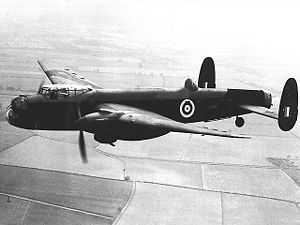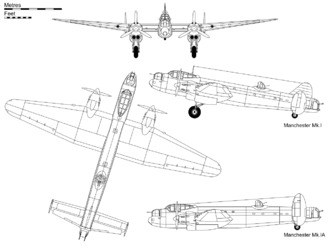- Avro Manchester
-
This article is about the Second World War bomber. For the First World War biplane, see Avro 533 Manchester.
Manchester Role Heavy bomber Manufacturer Avro First flight 25 July 1939 Introduction November 1940 Retired 1942 Primary users Royal Air Force
Royal Canadian Air ForceProduced 1940–1941 Number built 209 Developed into Avro Lancaster The Avro 679 Manchester was a British twin-engine heavy bomber developed during the Second World War by the Avro aircraft company in the United Kingdom. The Manchester was a failure due to its under-developed, under-powered, and unreliable engines, but was the forerunner to the famous Avro Lancaster, one of the most successful bombers of the war.
Contents
Design and development
The Manchester was originally designed to the Air Ministry Specification P.13/36 which was the same specification that Handley Page followed in their design of the Halifax bomber. The specification called for a twin-engine "medium bomber" for "worldwide use", which was to be capable of carrying out shallow (30°) dive bombing attacks, and carry heavy bombloads (8,000 lb/3,630 kg) or two 18 in (457 mm) torpedoes.[1] Provision for catapult assisted takeoff to permit the maximum load was also part of the specification. Cruising speed was to be a minimum of 275 mph at 15,000 feet. The Air Ministry were expecting an aircraft of similar weight to the B.1/35 specification but smaller and faster.
Avro had already started work on a design before the invitation to tender. They were in competition with Boulton Paul, Bristol, Fairey Handley Page and Shorts. Vickers had a design but did not tender it. In early 1937 the Avro design and the Handley Page were accepted, and prototypes of both ordered but in mid 1937, the Air Ministry exercised their rights to order "off the drawing board". This skipping of the usual process was necessary because of the expansion of the RAF in expectation of war. From 1939, it was expected that the P.13/36 would replace existing medium bombers in production.
The design used the Rolls-Royce Vulture 24-cylinder X-block engine, which was essentially two Rolls-Royce Peregrine Vee cylinder blocks mounted one on top of the other, the bottom one inverted to give the "X" shape. When developed in 1935, the engine had promise — it was rated at 1,760 hp (1,310 kW) - but it proved woefully unreliable and had to be derated to 1,480-1,500 hp (1,100-1,120 kW). Avro's prototype Manchester L7246 was assembled by their experimental department at Manchester's Ringway Airport and first flew from there on 25 July 1939, with the second aircraft following on 26 May 1940.[1] The Rolls-Royce engine was chosen by Avro and not stipulated by the Air Ministry as is sometimes claimed.[N 1] The Handley Page HP.56, always intended as the backup to the Avro, was redesigned to take four engines on the orders of the Air Ministry in 1937 as the Vulture was already showing problems.
While the Manchester was designed with twin tails, the first production aircraft, designated the Mk I, had a central fin added and a total of 20 aircraft with this configuration were completed. They were succeeded by the Mk IA which reverted to the twin-fin system but used enlarged, taller fin and rudders mounted on a new tailplane with span increased from 22 ft (6.71 m) to 33 ft (10.06 m). This configuration was carried over to the Lancaster, except for the first prototype, which also used a central fin.
Avro built 177 and Metropolitan-Vickers completed 32 aircraft. Plans for Armstrong Whitworth and Fairey Aviation at Stockport/Ringway to build the Manchester were abandoned. Fairey's order for 150 Manchesters was replaced by orders for Halifaxes.
Operational history
Handley Page's response to the engine's faults was to switch the Halifax to four of the less powerful but more reliable Rolls-Royce Merlin X engines. Avro however persisted with the Vulture and the Manchester went into production, entering service with No. 207 Squadron of RAF Bomber Command in November 1940, flying its first operational mission on 24–25 February 1941 in a raid on the French port of Brest.[4] [5] Eventually 209 Manchesters entered service, before production finished in November 1941,[5] equipping eight bomber squadrons, serving with two others and also being used by Coastal Command.
The Mk III Manchester, BT308, which first flew on 9 January 1941, was essentially the first Lancaster, being powered by four Merlin engines and with increased wingspan, although initially retaining the three fins and twin outboard rudders (the central fin had no movable control surface) of the Manchester I. BT308 received the "Lancaster" name immediately after its first flight. The second prototype Lancaster DG595 featured the twin, enlarged fins and rudders of the Manchester IA. Manchester production continued until November of that year but some aircraft still in production were completed as Lancasters.
The 193 operational Manchesters flew 1,269 operations with Bomber Command, dropping 1,826 tons (1,657 tonnes) of bombs and losing 63 aircraft in action, flying its last operation against Bremen on 25 June 1942.[6] Of the 78 aircraft lost, 45 were non-operational losses of which 30 involved engine failure.[7]
Variants
- Manchester L7246
- First prototype originally with twin tail. Due to lack of directional stability, it had a third fin added.
- Manchester I
- First production version with twin tail and additional central fin added; 20 of this type were built.
- Manchester IA
- Main production version with twin tail with enlarged tailplane. It also had taller fins and rudders.
- Manchester II
- Projected version re-engined with a pair of Napier Sabre or Bristol Centaurus engines. None built.
- Manchester III BT308
- This version was powered by four Merlin engines with increased wingspan; also, the three fins and rudders of the Manchester I were retained. This variant was the first prototype of the later Avro Lancaster.
Operators
Specifications (Manchester Mk I)
General characteristics
- Crew: 7
- Length: 70 ft (21.34 m)
- Wingspan: 90 ft 1 in (27.46 m)
- Height: 19 ft 6 in (5.94 m)
- Wing area: 1,131 ft² (105.1 m²)
- Empty weight: 31,200 lb (14,152 kg)
- Max takeoff weight: 50,000 lb (22,680 kg)
- Powerplant: 2 × Rolls-Royce Vulture I 24-cylinder X-type, 1,760 hp (1,310 kW) each
Performance
- Maximum speed: 265 mph (230 kn, 402 km/h) at 17,000 ft (5,180 m)
- Range: 1,200 miles (1,930 km) with maximum bomb load of 10,350 lb (4,695 kg)
- Service ceiling: 19,500 ft (5,852 m)
Armament
- Guns: 8 × 0.303 in (7.7 mm) Browning machine guns, (in Nash & Thomson nose (2), dorsal (2) and tail (4) turrets)
- Bombs: 10,350 lb (4,695 kg) bomb load
See also
- Related development
- Aircraft of comparable role, configuration and era
- Related lists
References
- Notes
- Citations
- Bibliography
- Buttler, Tony. British Secret Projects: Fighters and Bombers 1935–1950. Hickley, UK: Midland Publishing, 2004. ISBN 978-1857801798.
- Chant, Christopher. Lancaster: The History of Britain's Most Famous World War II Bomber. Bath, UK: Parragon, 2003. ISBN 0-75258-769-2.
- Holmes, Harry. Avro: The History of an Aircraft Company. Marlborough, UK: Crowood Press Ltd, Second edition, 2004. ISBN 1-86126-651-0.
- Holmes, Harry. Avro Lancaster (Combat Legend series). Shrewsbury, UK: Airlife Publishing Ltd., 2002. ISBN 1-84037-376-8.
- Jackson, A.J. Avro Aircraft since 1908. London: Putnam Aeronautical Books, Second edition, 1990. ISBN 0-85177-834-8.
- Jackson, Robert. Aircraft of World War II. Enderby, UK: Silverdale Books, 2006. ISBN 1-85605-751-8.
- Kirby, Robert. Avro Manchester: The Legend Behind the Manchester. Leicester, UK: Midland Publishing, 1995. ISBN 1-85780-028-1.
- Lewis, Peter. The British Bomber since 1914. London: Putnam, Second edition, 1974. ISBN 0-370-10040-9.
- Mackay, R.S.G. Lancaster in action. Carrollton, Texas: Squadron/Signal Publications Inc., 1982. ISBN 0-89747-130-X.
- Mason, Francis K. The British Bomber since 1914. London: Putnam Aeronautical Books, 1994. ISBN 0-85177-861-5
- "Manchesters". Aeromilitaria No. 2. Tonbridge, Kent, UK: Air-Britain (Historians) Ltd., 1990.
- Sinnott, Colin. The RAF and Aircraft Design 1923–1939: Air Staff Operational Requirements (Studies in Air Power). London: Frank Cass, 2001. ISBN 978-0714651583.
- Thetford, Owen. Aircraft of the Royal Air Force 1918-57. London: Putnam, First edition, 1957. ISBN 0-37000-101-X .
External links
Avro aircraft Manufacturer designations Type D · Type E · Type F · Type G · Type H
500 · 501 · 502 · 503 · 504 · 508 · 510 · 511 · 513 · 519 · 521 · 522 · 523 · 527 · 528 · 529 · 530 · 531 · 533 · 534 · 536 · 538 · 539 · 545 · 546 · 547 · 548 · 549 · 550 · 551 · 552 · 553 · 554 · 555 · 556 · 557 · 558 · 560 · 561 · 562 · 563 · 566 · 567 · 571 · 572 · 574 · 575 · 576 · 578 · 578 · 580 · 581 · 584 · 586 · 587 · 594 · 597 · 604 · 605 · 608 · 609 · 611 · 612 · 613 · 616 · 617 · 618 · 619 · 620 · 621 · 624 · 625 · 626 · 627 · 631 · 632 · 633 · 636 · 637 · 638 · 639 · 640 · 641 · 642 · 643 · 644 · 646 · 652 · 655 · 656 · 663 · 664 · 665 · 666 · 668 · 670 · 671 · 672 · 674 · 675 · 679 · 680 · 681 · 682 · 683 · 684 · 685 · 686 · 688 · 689 · 691 · 682 · 694 · 695 · 696 · 698 · 701 · 706 · 707 · 711 · 720 · 721 · 724 · 726 · 728 · 729 · 730 · 731 · 732 · 735 · 748 · 776 · 784
By role BombersTransportsAndover · Lancastrian · York
Maritime patrolAnson · Bison · Shackleton
Passenger transportsTrainersFightersSports planesExperimentalAero enginesA.V. Roe 20 hp 2-cyl.
Lists relating to aviation General Aircraft (manufacturers) · Aircraft engines (manufacturers) · Airlines (defunct) · Airports · Civil authorities · Museums · Registration prefixes · Rotorcraft (manufacturers) · TimelineMilitary Accidents/incidents Records Categories:- Avro aircraft
- British bomber aircraft 1930–1939
- World War II British bombers
Wikimedia Foundation. 2010.



